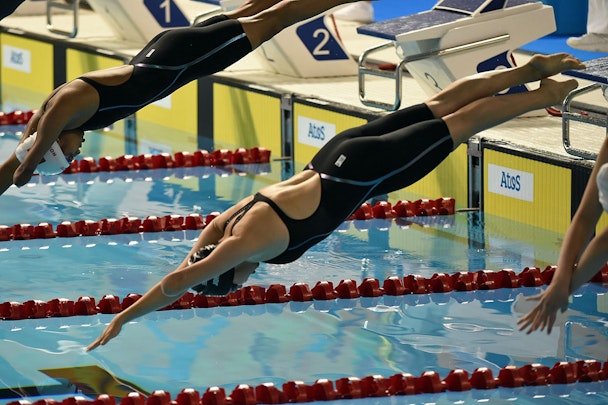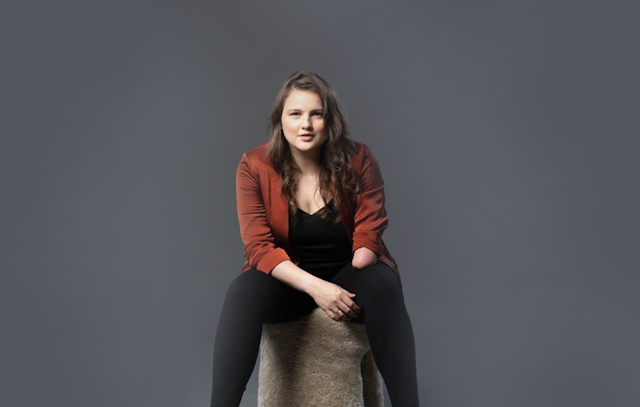
Advertisement

Anna Johannes, Paralympic athlete turned brand advisor
As part of The Drum’s Sports Marketing Deep Dive, we sit down with Paralympic medalist turned Interbrand strategist Anna Johannes to find out how she is educating the world’s biggest brands about inclusive design.
Meet Anna Johannes. She has a message that you probably don’t want to hear: it’s time to stop patting yourself on the back for those fluffy ‘inclusivity’ ads if you’re not doing the hard work to make your brand accessible for all.
Exactly 10 years ago, the swimmer won bronze at the London Paralympics. Those games, she recalls, should have been a turning point in the way people think about disability. A decade on, however, research shows little has changed and companies still rarely consider how people with a disability experience their brands, much less represent them in their advertising campaigns. Johannes’s next extraordinary feat will be to change that.
Spearheading Interbrand’s new Inclusive Design division, the strategist has been tasked to work directly with the agency’s top clients, such as Unilever and Estee Lauder, and to educate the entire agency on designing for disabilities. First, though, she has some home truths for them all about why the work they are doing in an attempt to tick boxes simply isn’t enough.

Injury scuppered Johannes’s plans to compete at Rio 2016 and ultimately put her into unexpected retirement at just 23 years old. So instead she graduated from college, consulted for Speedo on the hire of its first Paralympian brand ambassador and then moved over to its then-sister brand Tommy Hilfiger for a short-lived stint as a sales and marketing rep for its range of swimsuits designed for disabled athletes.
“I realized very quickly that sales wasn’t for me,“ Johannes tells The Drum. “It takes a very specific personality that I did not have, but I’m OK admitting that.”
Next was a couple of years in the marketing department of Boston Children’s Hospital, which she says was pivotal in broadening her experience beyond “just disability” work, before she switched gear entirely and moved agency side, joining Omnicom Group’s Porter Novelli and setting the trajectory for her career since.
“Fenella Gray, the chair of Porter Novelli’s London office, is really passionate about disability and really took me under her wing,” Johannes explains. Gray pushed for her to work on ’We The 15’, a campaign being developed with Adam&EveDDB for the International Paralympic Committee. A 10-year commitment to spotlighting the 1.2 billion people in the world living with a disability, it needed an ad campaign that would dispel stereotypes or any notions that they should be pitied or placed on a pedestal. Despite the brief, it was an eye-opener for Johannes on how far the industry still had to go in making that a reality. She says she was the only disabled person working on the advertising portion of that campaign.
“It started off being a lot of able-bodied people coming up with a campaign for disabled people. There is a disconnect between what marketing thinks disability is and what disability actually is. I was the only disabled person on our phone calls, the only disabled voice in the room making sure the work would resonate with people with disabilities and that we weren’t using disability as a prop to tell the story, but telling the real stories of what it’s like being disabled.”
The end campaign was a huge success, winning multiple awards for its bold, funny and honest portrayal of living with a disability. But once again, its acclaimed reception highlighted yet another failure of the advertising industry.
“I loved working on ’We The 15’. And it’s great that it’s winning a lot of awards. But when you look at who’s getting on stage – and I’m probably going get in trouble for saying that, but that’s OK – those aren’t the people with disabilities who helped make sure that it became the success it is.
“And so, you know, were they listening to people with disabilities? Were we included? Were we hired? I don’t know... If a campaign was made for women and then a bunch of men got credit for a campaign that women helped create... I mean, that stuff is happening, but it would be more of a front-page news situation. Check your bias, do the work.“
Johannes joined Interbrand to make sure brands do just that. The global agency quietly launched its Inclusive Design practice last May, led by Marianne Waite, with the goal of helping brands to achieve what it calls a ‘barrier-free brand experience’. The division will work across sectors to ensure every touchpoint of a brand is inclusive, from how a retailer’s store is laid out, how an app functions, how the physical product has been designed through to hiring staff and employee training that ensures attitudes towards disability are right.
“Marketing should really be the last focus because you can’t talk about something until you do the work. But right now, it’s the opposite.”
Recalling an ad she saw recently for a clothing company, she says: ”The kid had an arm like mine [Johannes was born with amniotic band syndrome] and they had just rolled the sleeve right up. Why wouldn’t you just tailor it to this dude’s arm?”
It is just one of many examples she could give of the small details that make it clear the people on the screen are still rarely involved in an ad’s making – and even less so in the product being sold.
Brands are too quick to produce the glossy ad campaign that gives an illusion of inclusivity, she says, which is a product of our culture right now. She says there’s a fear among marketers that if they don’t “tick a bunch of boxes” for their consumer-facing campaigns, their brand will “immediately be called out”.
“But they don’t listen to people with disabilities and then they release something that isn’t right for people with disabilities. So people with disabilities get upset and then marketers are like: ‘Whoa, why aren’t you happy just to have something for you?’ It’s because you didn’t listen to us, you know?”
This leans into what Johannes is doing with Interbrand. “The concept of Inclusive Design isn’t just designing what we call ‘disability dongles’ – a very specific thing made for people with disabilities that no one with a disability wanted or asked for. Brands are like: ‘Just be happy that we created this for you.’ But that’s designing for disability, not inclusive design.“
Weaning brands off these all-too-transparent shortcuts and asking them to rethink their entire approach is not an easy pitch, with Johannes saying that while there’s no shortage of brands intrigued by Interbrand’s proposal as they try and tap into the purple pound (in the UK alone, the collective buying power of the 14.1 million people with a disability is an estimated £249bn), they still pause when they realize the potentially hefty investment they have to make to do it right.
“They get on a phone call with us and say: ‘We’ll have to think about this because our budget was like $10,000’,” she laughs. “So it is a long process, but the brands that we have activated with, like Unilever and Estee Lauder, knew it was going to take a moment and some money.”
Her new role is also about making sure she’s not just talking with a brand’s ‘chief accessibility officer’ or someone else relegated to DE&I. While these roles are undoubtedly important, by not having the C-suite on board from the outset she’s found the ‘inclusivity’ efforts simply end up segregated from what the rest of the company is doing.
It also means hiring. There are still too few people with disabilities in the room when decisions are being made, be that product development or marketing. ”Inclusive design starts from the very beginning, from listening to people with disabilities and then making sure it transcends everything – that CEO, CFOs and CMOS are all aware and that the whole C-suite is part of it.”
This work with Interbrand, she hopes, will go some way to bridging the ”disconnect” that currently exists between the DE&I work brands embark on and those they are trying to connect with.
”We can’t fall out of a basement. We can only really go up. It’s exciting, even if there are some fails here, some wins there. Even if there are misunderstandings, it’s all going in a good direction and we have to learn together, you know? Everyone’s going to fail, but it’s about getting back up and saying ’my bad’ rather than being so scared of progress.”
Check out The Drum’s latest Deep Dive, The New Sports Marketing Playbook, and learn the tactics employed by the world’s biggest sports organizations and their star athletes to stay at the top of their game.